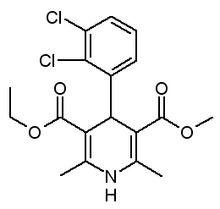METHOD OF PREPARATION
1. Calculate the required quantity of each ingredient for the total amount to be prepared.
2. Accurately weigh and/or measure each ingredient.
3. If capsules are used, pulverize the capsule contents to a fine powder, or use bulk isradipine powder.
4. Add the glycerin and mix to form a smooth paste.
5. Add the syrup slowly, with mixing, to volume and mix well.
6. Package and label.
PACKAGING
Package in tight, light-resistant containers.
LABELING
Keep out of reach of children. Use only as directed. Shake well before taking.
STABILITY
A beyond-use date of 35 days can be used for this preparation.1,2
USE
Isradipine oral liquid is used as a calcium channel blocker in the management of hypertension.
QUALITY CONTROL
Quality-control assessment can include weight/volume, pH (pH 5 to 7), specific gravity, active drug assay, color, rhcological properties/pourability, physical observation, and physical stability (discoloration, foreign materials, gas formation, mold growth).3
DISCUSSION
Isradipine is a 1,4-dihydropyridine-derivative calcium channel blocker that is structurally related to felodipine, nifedipine, and nimodipine. It is used in the management of hypertension.4
Isradipine USP (C^sub 19^H^sub 21^N^sub 3^O^sub 5^, MW 371.39, DynaCirc) occurs as a yellow, fine crystalline powder.2 It is commercially available as 2.5- and 5-mg oral capsules. The 2.5-mg capsule also contains colloidal silicon dioxide, FD&C Red No. 7 Calcium Lake, FD&C Yellow No. 6 Aluminum Lake, gelatin, lactose, starch, titanium dioxide, benzyl alcohol, butylparaben, edetate calcium disodium, methylparaben, propylparaben, and sodium propionate. The 5-mg capsules contain colloidal silicone dioxide, FD&C Red No. 7 Calcium Lake, FD&C Red No. 40, FD&C Yellow No. 6 Aluminum Lake, gelatin, lactose, starch, titanium dioxide, benzyl alcohol, butylparaben, edetate calcium disodium, methylparaben, propylparaben, and sodium propionate.5
Glycerin (C^sub 3^H^sub 8^O^sub 3^, MW 92.1, glycerol, 1,2,3-propane triol) occurs as a clear, colorless, odorless, viscous, hygroscopic liquid with a sweet taste about two thirds as sweet as sucrose. It is used as an antimicrobial preservative (>20% concentration), an emollient and humectant (up to 30% concentration), a plasticizer in film coating for tablets, a parenteral solvent (up to 50% concentration), a sweetening agent in alcoholic elixirs (up to 20% concentration), and in ophthalmic formulations (0.5% to 3% concentration). It has a specific gravity of about 1.25 and a melting point of 17.8°C; if cooled to crystallization, it will need to be heated to about 20°C to melt. It is miscible with water, methanol, and 95% ethanol; practically insoluble in oils and chloroform; and slightly soluble in acetone. It is hygroscopic and should be stored in airtight containers in a cool place. It is not prone to oxidation but will decompose on heating. Mixtures with water, ethanol, or propylene glycol are chemically stable. Incompatibilities include strong oxidizing agents, such as chromium trioxide, potassium chlorate, and potassium permanganate, with which it may explode. When mixed with zinc oxide or basic bismuth nitrate and exposed to light, it will form a black discoloration. When mixed with phenols, salicylates, or tannin, a darkening of the mixtures may occur owing to an iron contaminant in the glycerin. It will also form a strong acid complex, glyceroboric acid, when mixed with boric acid.6
Syrup NF (simple syrup) is a clear, sweet vehicle used as a sweetening agent and as a base for many flavored and medicated syrups. It contains 85% w/v sucrose in water and has a specific gravity of not less than 1.30. It is generally self-preserving, as long as the sucrose concentration is maintained at a sufficiently high level. Preparation without the use of heat is preferred, but it can be prepared with boiling water. It should be stored in tight containers, preferably in a cool place.2
References
1. MacDonald JL, Johnson CE, Jacobson P. Stability of isradipine in an extemporaneously compounded oral liquid. Am J Hosp Pharm 1994; 51(19): 2409-2411.
2. US Pharmacopeial Convention, Inc. USP-Pharmacists' Pharmacopeia. Rockville, MD: US Pharmacopeial Convention, Inc.; 2005: 388, 408-431, 692.
3. Allen LV Jr. Standard operating procedure for quality assessment of oral and topical liquids. IJPC 1999; 3(2): 146-147.
4. McEvoy GK, ed. AHFS Drug Information-2005. Bethesda, MD: American Society of Health-Systems Pharmacists; 2005:1817-1819.
5. [No author listed.] Physicians' Desk Reference. 58th ed. Montvale, NJ: Thomson PDR; 2004: 2870-2873.
6. Price JC. Glycerin. In: Rowe RC, Sheskey PJ, Weller PJ, eds. Handbook of Pharmaceutical Excipients. 4th ed. Washington, DC: American Pharmaceutical Association; 2003: 257-259.
Copyright International Journal of Pharmaceutical Compounding Nov/Dec 2005
Provided by ProQuest Information and Learning Company. All rights Reserved



